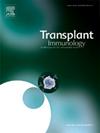Pre-transplant compatibility testing: Transition from CDCXM to flow cytometry in India
IF 1.4
4区 医学
Q4 IMMUNOLOGY
引用次数: 0
Abstract
Over 60 % of kidney transplant candidates are non-sensitised while remaining 40 % are sensitised because of previous exposure to human alloantigens during previous transplants, blood transfusions, and pregnancy in women. Pre-transplant compatibility testing is mandatory prior to renal transplantation for detecting the presence of donor-specific antibodies (DSAs), which are associated with early hyperacute/acute and later chronic rejections. Initially, complement-dependent cytotoxicity crossmatch (CDCXM) was used as a traditional method for detecting preformed DSAs. However, its limited sensitivity fails to detect low-level antibodies, and all non-complement-binding antibodies lead to early graft rejection despite a negative CDC-XM result. Flow cytometry crossmatch (FCXM), introduced in 1983, addresses these limitations by offering superior sensitivity in detecting DSAs. FCXM uses indirect immunofluorescence to differentiate T cell (expressing class I HLA) and B cell (expressing class I/II HLAs) reactivities providing a more precise assessment of DSAs, significantly decreasing the risk of rejection. Studies demonstrate that positive FCXM results, even with negative CDC-XM, correlate with higher rejection rates and reduced graft survival. Various modifications, including pronase treatment and especially streamlined Halifax and Halifaster protocols, have improved the test's specificity and speed. Despite its advantages, FCXM is also susceptible to potential false-positive and false-negative results because of non-HLA antibodies, cross-reactivity with therapeutic agents, and other technical factors. Nonetheless, FCXM remains a gold standard in modern transplantation immunology, enhancing safety of graft outcomes through better identification of immunologically significant DSAs. This review outlines the transition from CDCXM to FCXM in the Indian context, emphasizing its impact on pre-transplant testing and clinical decision-making.
移植前相容性测试:印度从CDCXM到流式细胞术的过渡。
超过60% %的肾移植候选者不敏感,而剩余的40% %由于先前移植、输血和妇女怀孕期间接触过人类同种异体抗原而敏感。移植前相容性测试是强制性的,用于检测供体特异性抗体(dsa)的存在,这与早期超急性/急性和后来的慢性排斥反应有关。最初,补体依赖性细胞毒性交叉匹配(CDCXM)是检测预成型dsa的传统方法。然而,其有限的敏感性无法检测低水平抗体,并且尽管CDC-XM结果为阴性,但所有非补体结合抗体都会导致早期移植排斥反应。1983年引入的流式细胞仪交叉匹配(FCXM)通过在检测dsa方面提供卓越的灵敏度来解决这些限制。FCXM使用间接免疫荧光区分T细胞(表达I类HLA)和B细胞(表达I/II类HLA)的反应性,提供更精确的dsa评估,显著降低排斥反应的风险。研究表明,FCXM阳性结果,即使是CDC-XM阴性,也与更高的排异率和更低的移植物存活率相关。各种改进,包括pronase治疗,特别是简化的Halifax和Halifaster方案,提高了测试的特异性和速度。尽管FCXM具有优势,但由于非hla抗体、与治疗药物的交叉反应性和其他技术因素,FCXM也容易出现潜在的假阳性和假阴性结果。尽管如此,FCXM仍然是现代移植免疫学的金标准,通过更好地识别具有免疫学意义的dsa来提高移植结果的安全性。这篇综述概述了在印度从CDCXM到FCXM的转变,强调了其对移植前检测和临床决策的影响。
本文章由计算机程序翻译,如有差异,请以英文原文为准。
求助全文
约1分钟内获得全文
求助全文
来源期刊

Transplant immunology
医学-免疫学
CiteScore
2.10
自引率
13.30%
发文量
198
审稿时长
48 days
期刊介绍:
Transplant Immunology will publish up-to-date information on all aspects of the broad field it encompasses. The journal will be directed at (basic) scientists, tissue typers, transplant physicians and surgeons, and research and data on all immunological aspects of organ-, tissue- and (haematopoietic) stem cell transplantation are of potential interest to the readers of Transplant Immunology. Original papers, Review articles and Hypotheses will be considered for publication and submitted manuscripts will be rapidly peer-reviewed and published. They will be judged on the basis of scientific merit, originality, timeliness and quality.
 求助内容:
求助内容: 应助结果提醒方式:
应助结果提醒方式:


